FC Barcelona hosted FC Bayern on matchday three of the UEFA Champions League.
Both teams, known for their aggressive and high-risk pressing styles, were set to deliver one of the most eventful evenings of football in a long time.
Our tactical analysis of the match offers analysis and insight into both teams’ high-pressing tactics, which set the tone for the contest we witnessed.
Barcelona operated in a nominal 4-2-3-1 formation, with Robert Lewandowski as a target man and the quick Raphinha on the left wing.
Under Vincent Kompany’s coaching style, Bayern also
played in a nominal 4-2-3-1, with Raphaël Guerreiro at right backand Joshua Kimmich in the holding midfield role.
A dynamic back-and-forth quickly developed, driven by both teams’ pressing and their high defensive lines.
Barcelona’s Build-Up Vs Bayern’s Attacking Pressing
Bayern pressed right from the first minute, as usual, with man-to-man orientation across the entire pitch.
Guerreiro pushed up against the opposing full-back, while Dayot Upamecano, on the ball-near side, defended against Barcelona’s left winger, Raphinha.
Barcelona’s build-up play was accordingly adapted to Bayern’s pressing.
The goal was to lure the opposing players in by using the numerical +1 advantage with the help of the goalkeeper, thereby creating more space behind the opponent.
By using opposing movements along Bayern’s high defensive line, Barcelona aimed to disrupt their man-marking and get in behind the defence.
Additionally, they sought to repeatedly pull the center-backs out of Bayern’s high defensive line.
This approach worked brilliantly in the very first minute.
Robert Lewandowski, dropping deep, was used by full-back Alejandro Balde as a target man, pulling centre-back Kim Min-jae out of position.
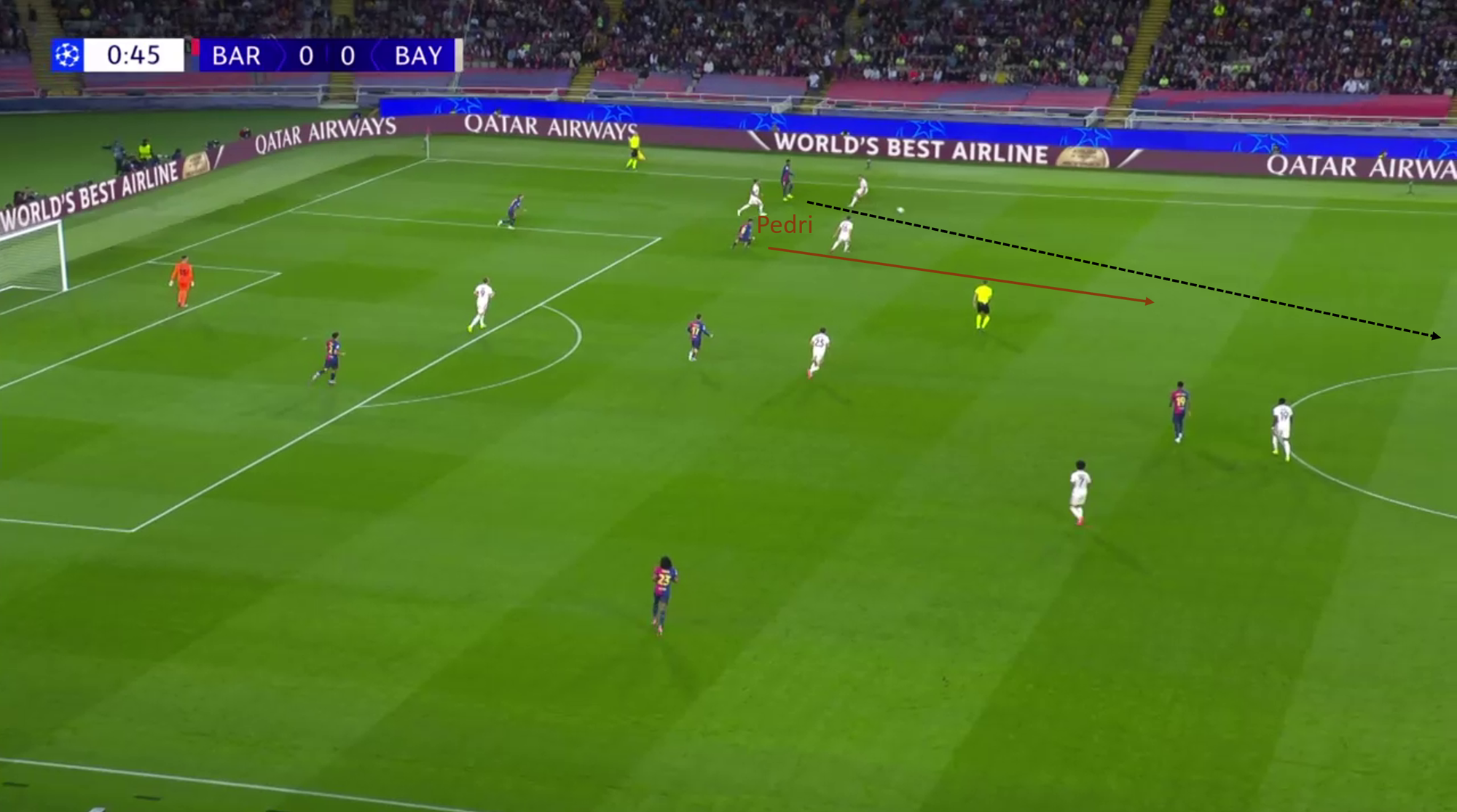
The overlapping midfielder, Pedri, was used as a layoff option while the No. 10, Fermín López, moved outward, and winger Raphinha cut inside to the last line.
This created a handover moment between Kimmich and Upamecano, who were operating on the last line, which was enough to play the deep-running Raphinha relatively free.
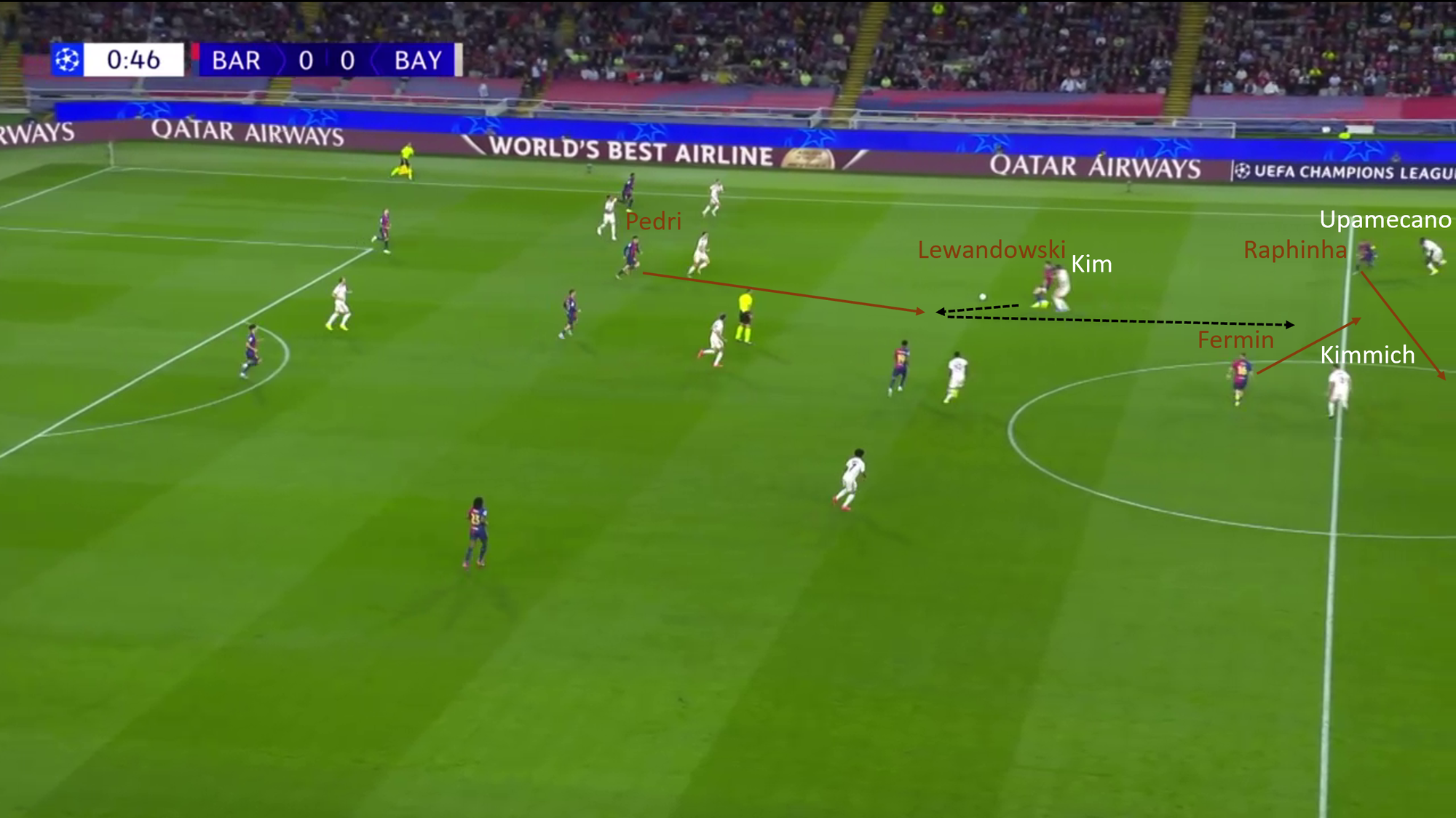
This also resulted in a mismatch, with the fast Raphinha in a footrace against the slower Kimmich.
As a result, Barcelona scored the opening goal to make it 1-0.
Further variations of how Barcelona played through Bayern’s man-oriented pressing are outlined below.
Variation 1:
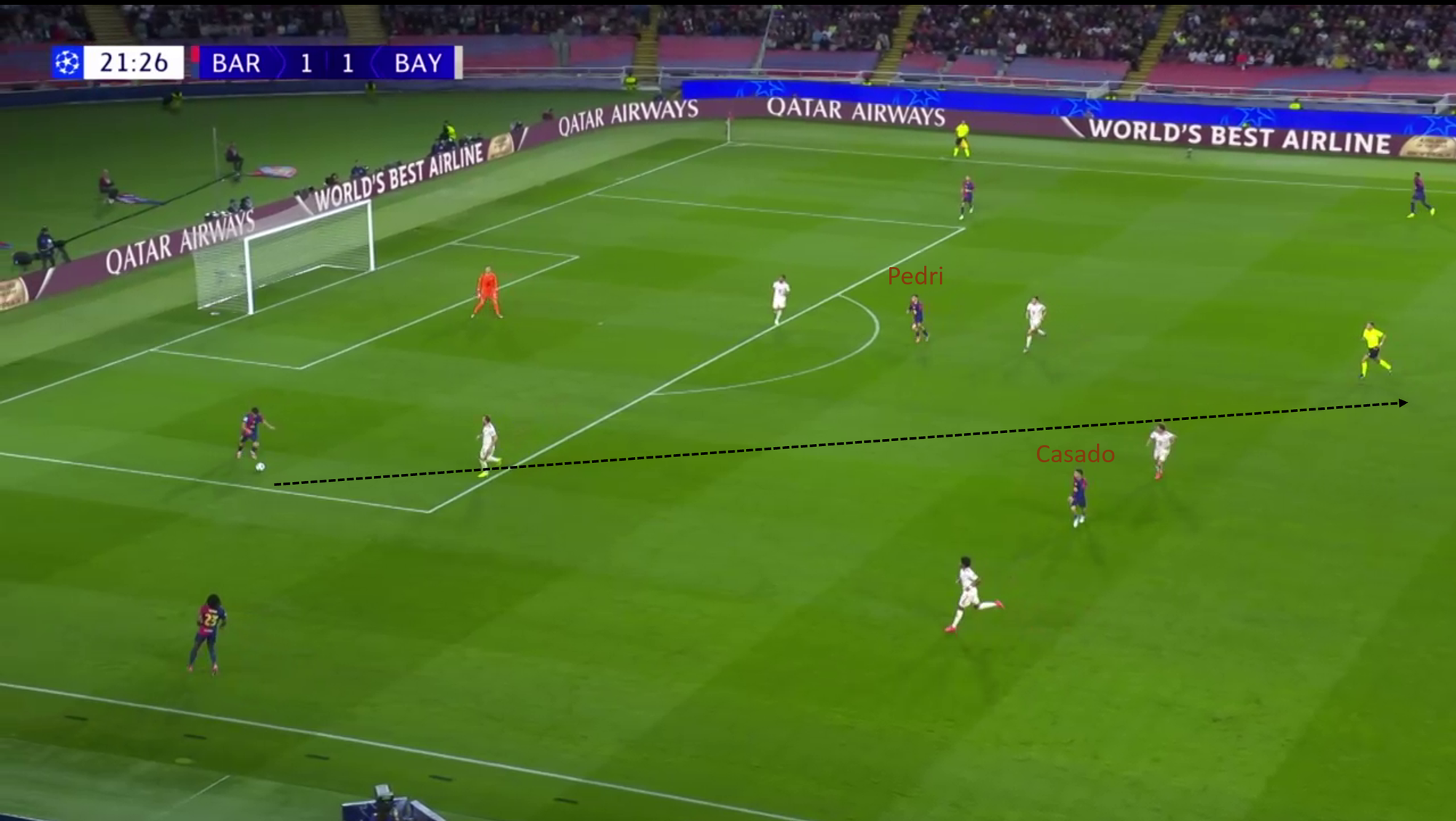
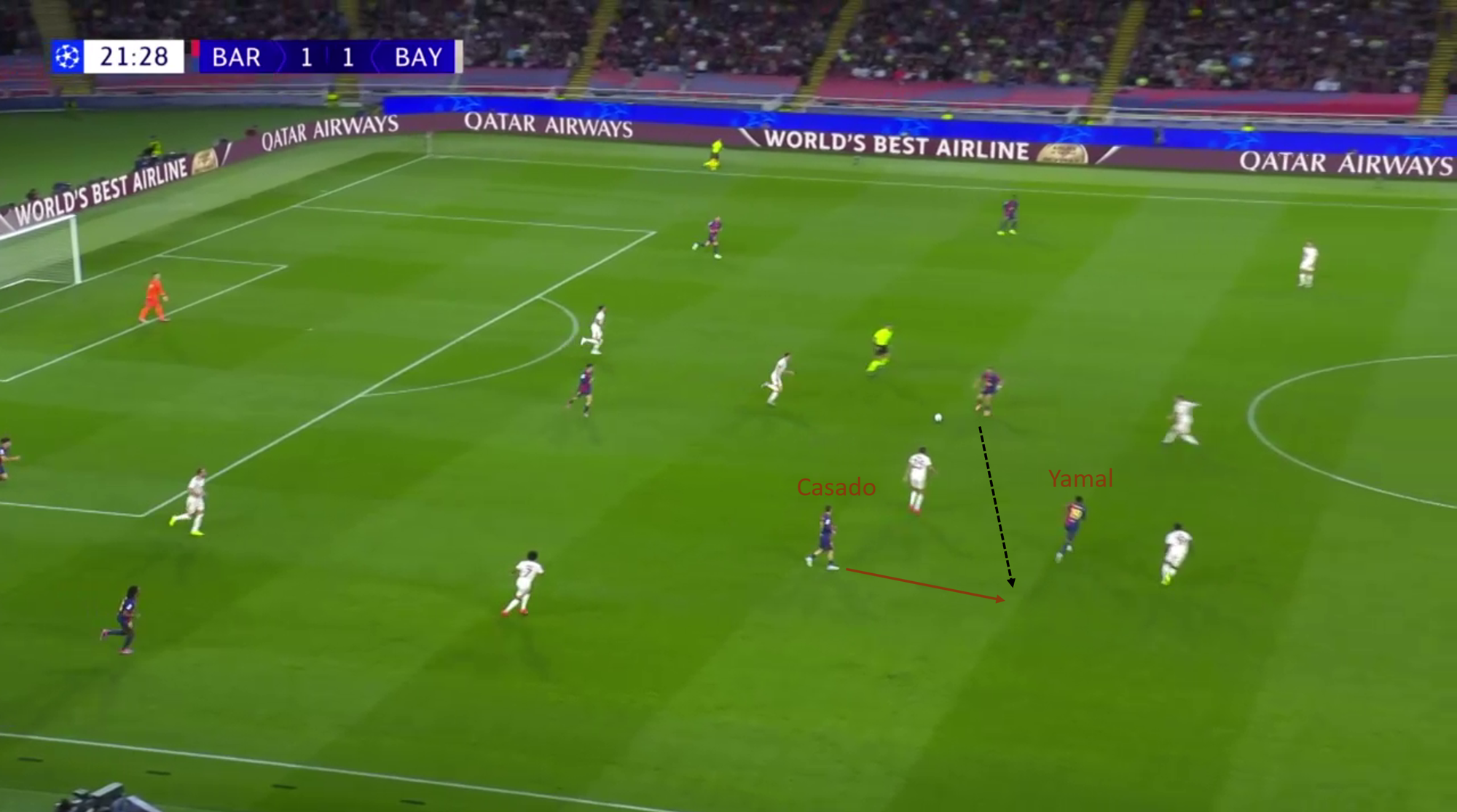
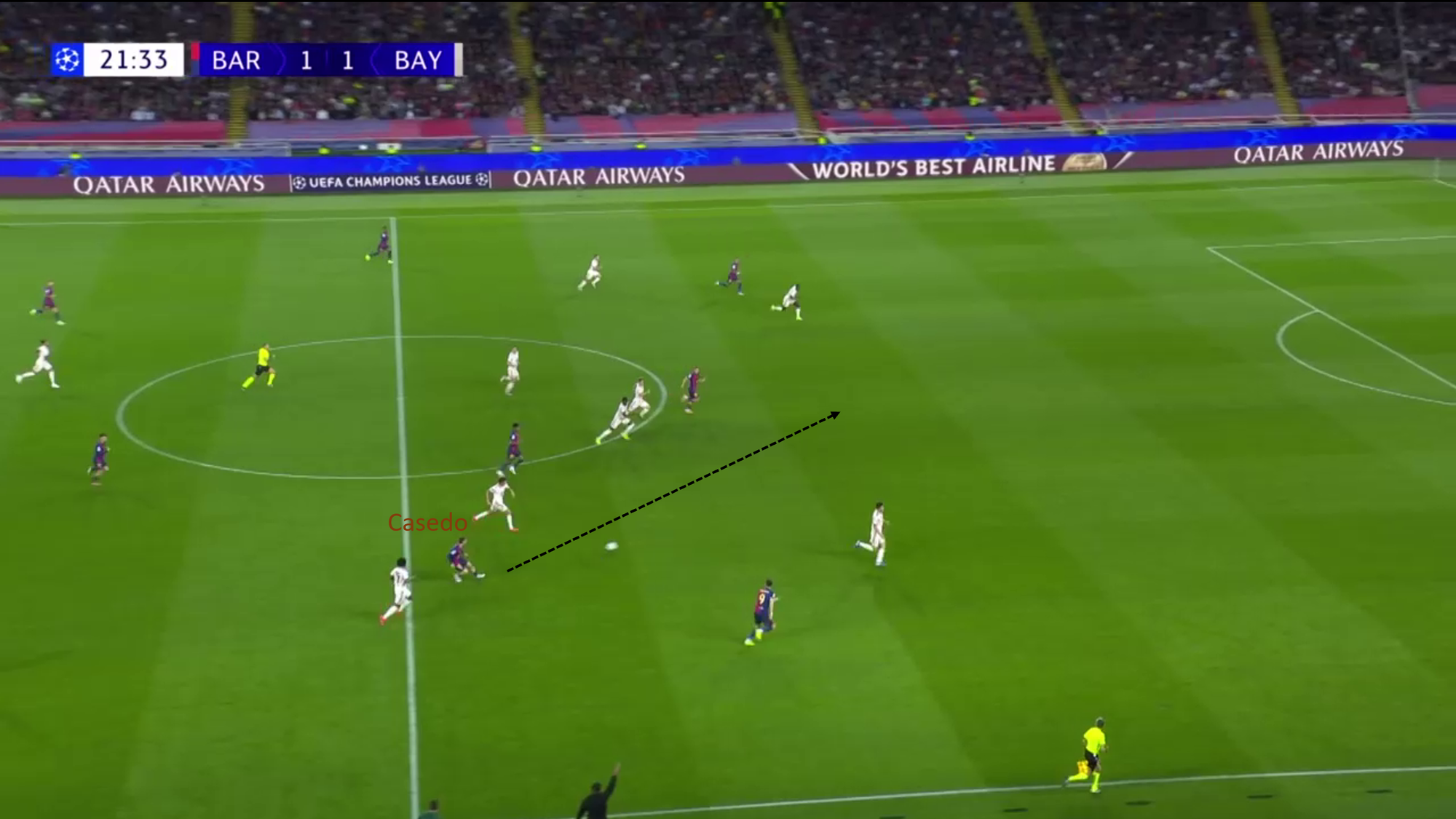
Variation 2:
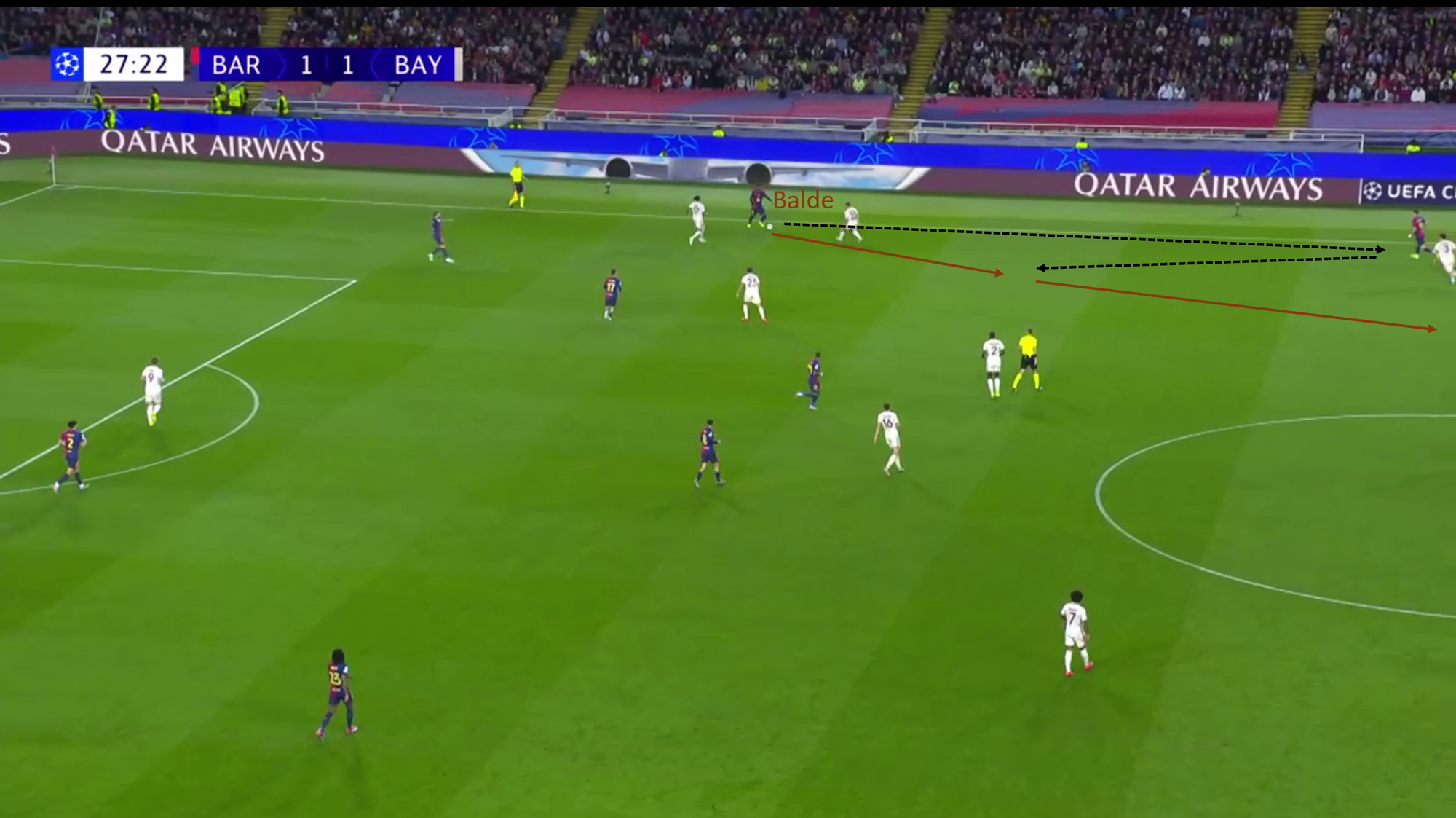
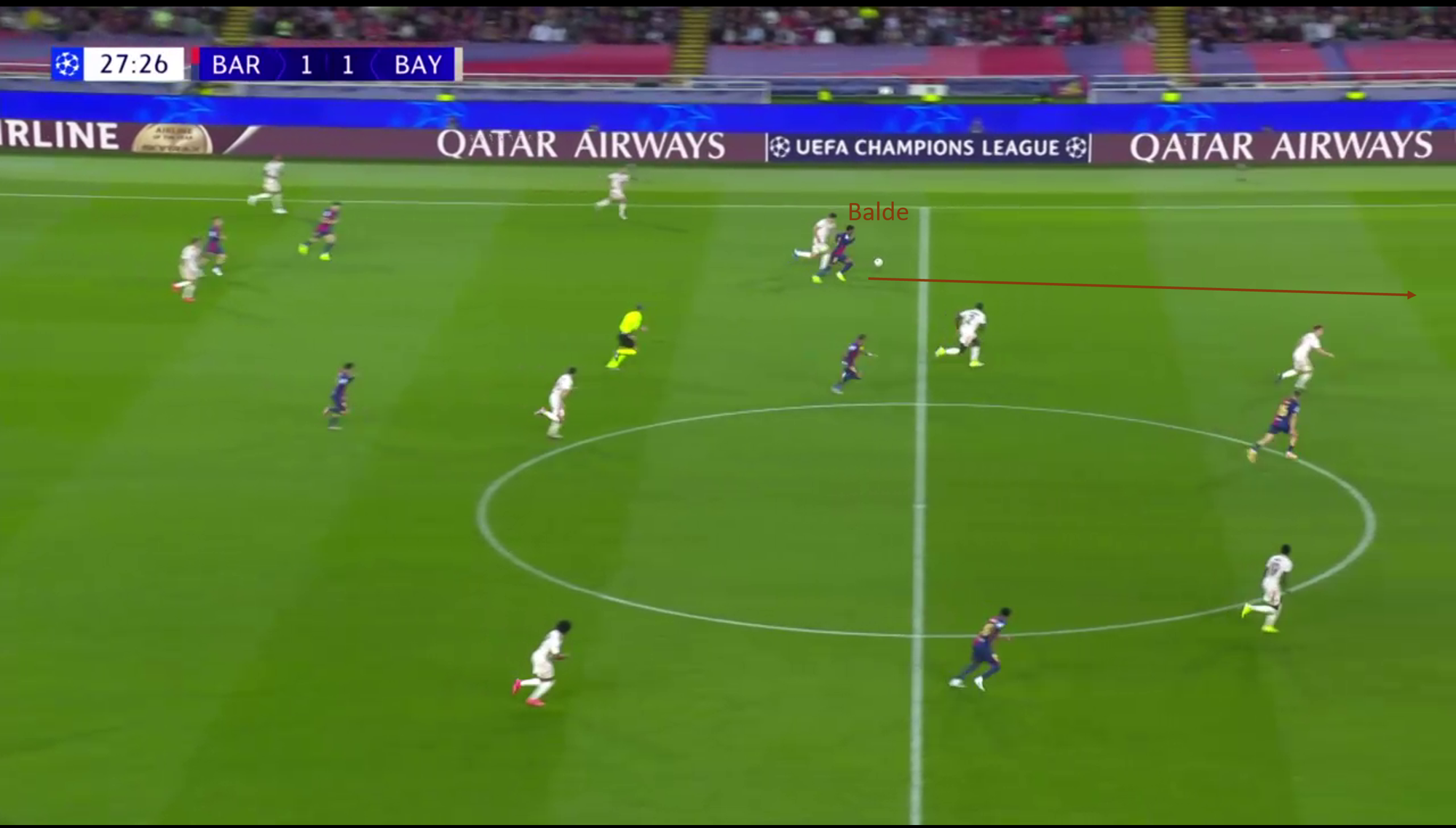
Bayern’s Solutions Against Barcelona’s Midfield Pressing
Following the 1-0 lead, Vincent Kompany’s tactics changed, and Bayern took control of the game, aided by their highly effective man-oriented attacking pressing.
Barcelona operated primarily in midfield pressing when out of possession, trying to avoid being pushed back into their own half by constantly pushing their defensive line high up the pitch.
This aimed to make the space between the lines very tight.
However, this also created a significant amount of space behind the defence.
To defend against this, Hansi Flick’s style of play relied on a particularly risky tactic.
They attempted to use aggressive offside traps to prevent Bayern from exploiting these spaces.
This led to some completely absurd situations, as seen in the 16th minute.
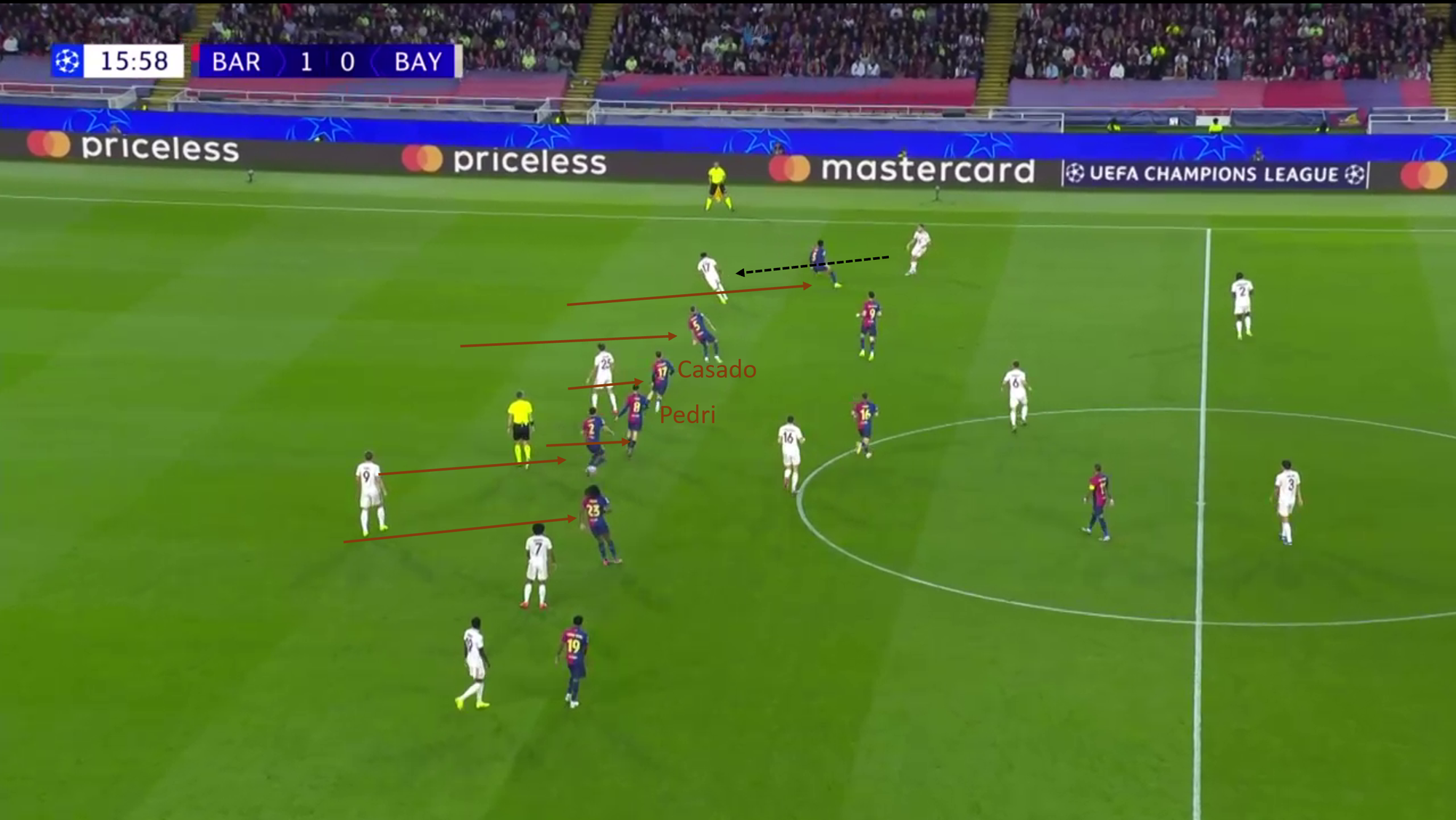
In midfield pressing, Barcelona defended with a 4-2 chain in space under Hansi Flick’s formation.
While the back four consistently pushed up in a space-oriented manner, the two holding midfielders also remained space-oriented right in front of Barcelona’s last line, sometimes even dropping deeper, which led to the formation of a five- or six-man defensive line at times.
By pressing diagonally toward the ball, they aimed to create numerical superiority in the ball-near areas.
Therefore, Barcelona did not allow Harry Kane and Thomas Müller to pull them out of the last line; instead, they aimed to stay active and control the game even without the ball.
However, a significant issue was that Barcelona applied little pressure on the ball carrier from Bayern’s first pressing line.
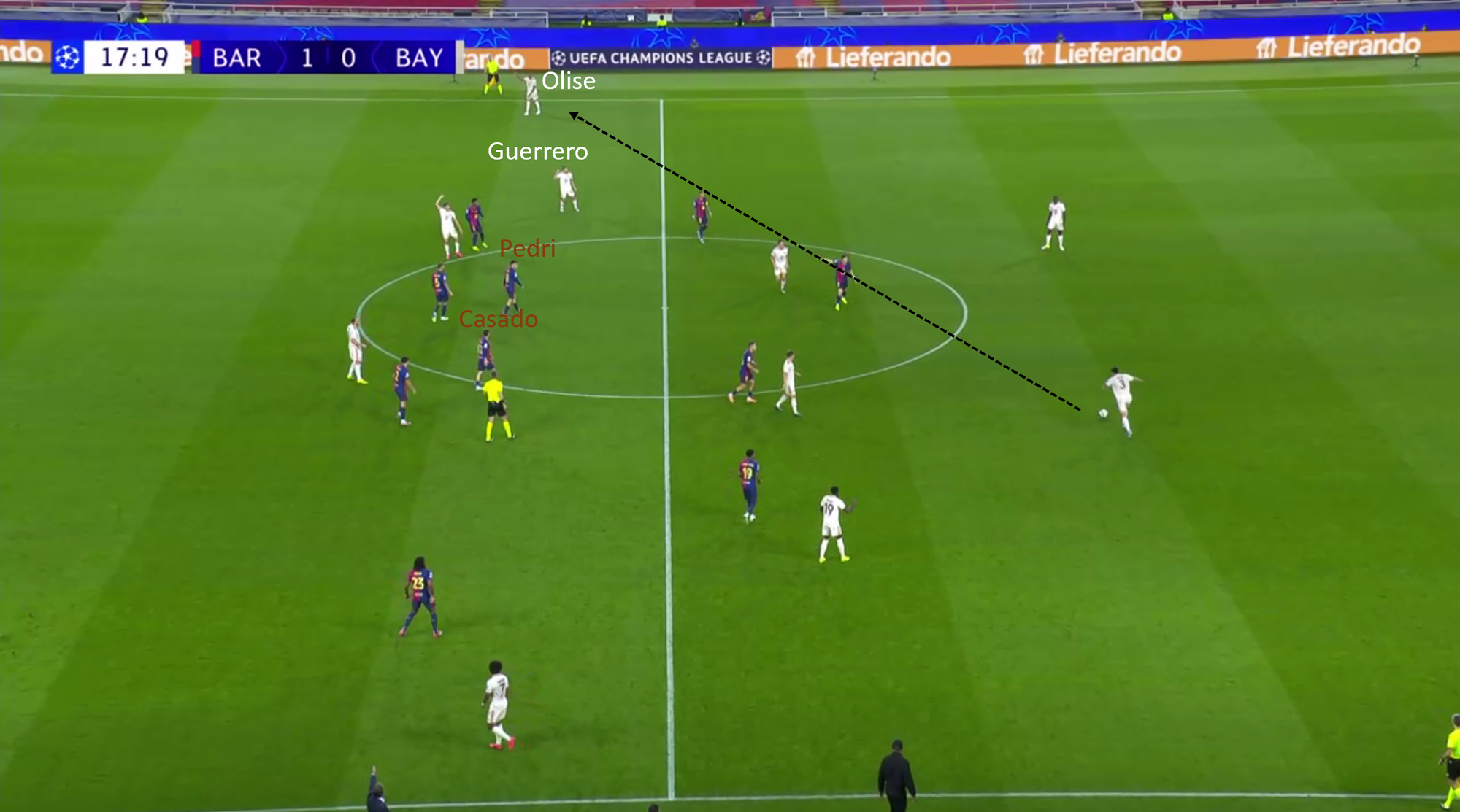
Bayern found an effective solution early on against Barcelona’s deeper midfield pressing and their offside trap.
With several timed runs into space, they aimed to attack the depth that emerged, particularly after Barcelona pushed forward.
To avoid being caught offside too often, they frequently made diagonal switches of play to the completely wide-positioned wingers.
Additionally, Bayern’s full-backs positioned themselves directly behind these wingers in the half-space, creating a 2v1 overload against the advancing Barcelona full-back after the switch, or they looked to make direct runs into the depth.
The full-backs positioned in the half-space at midfield also served as passing options in build-up play, allowing Bayern to bypass Barcelona’s first pressing line in their slightly higher midfield pressing.
Bayern overloaded the half-space with Kane, Kimmich, João Palhinha, Guerreiro, and Alphonso Davies and consistently found the free man.
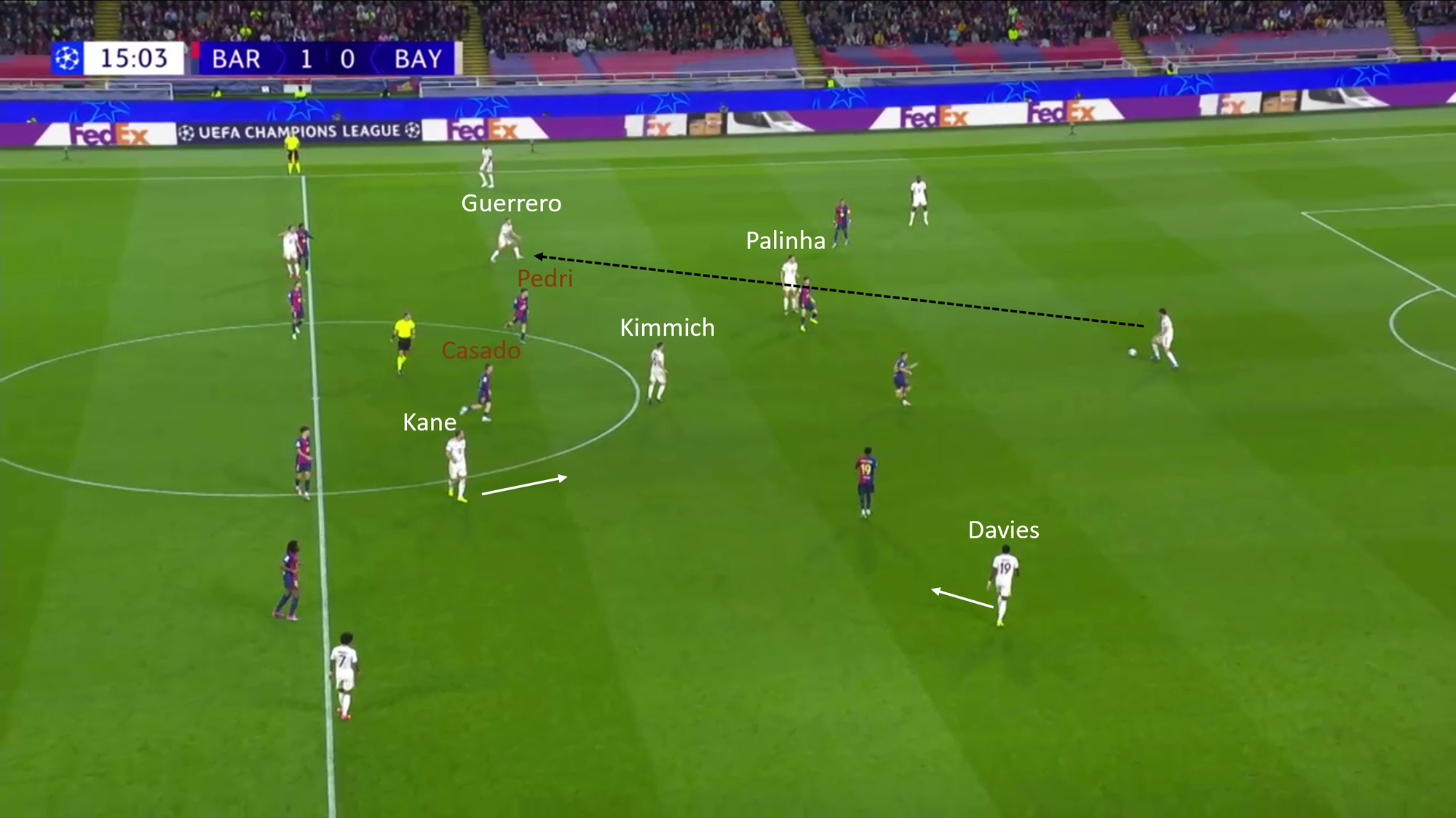
Raphinha was consistently put in a dilemma between pressing Upamecano and creating a cover shadow on Guerreiro.
As a result, Barcelona struggled to win the ball in their slightly higher midfield pressing and had to rely on their advancing defensive line to try to prevent Bayern’s deep runs.
This ultimately led to a deserved equaliser at 1-1.
Barcelona’s Attacking Pressing
Following the 1-1 equaliser, Barcelona regained more control of the game.
Also, because Bayern were not pressing as aggressively in their man-oriented attacking pressing and were operating more patiently, Barcelona felt more confident in building up play from the back.
With the assistance of the technically gifted Pedri and Lamine Yamal, they were able to free themselves from pressure situations more frequently and accumulate periods of possession.
Most importantly, Barcelona regained more control of the game through a tactical adjustment.
By positioning Pedri in the left half-space to press Guerreiro or Marc Casado in the right half-space against Kane in a man-oriented manner, while the ball-far player continued to provide space-oriented coverage in front of the defensive line, Barcelona were able to push forward into attacking press with a hybrid approach that combined man and space orientation.
This allowed them to apply pressure on the ball carrier repeatedly.
From this man-oriented setup, Barcelona directed Bayern to one side, where they shifted strongly toward the ball to maximise the pressure on the ball carrier.
Thus, they no longer had to rely on the increasingly risky offside trap.
The game shifted significantly more often into Bayern’s half.
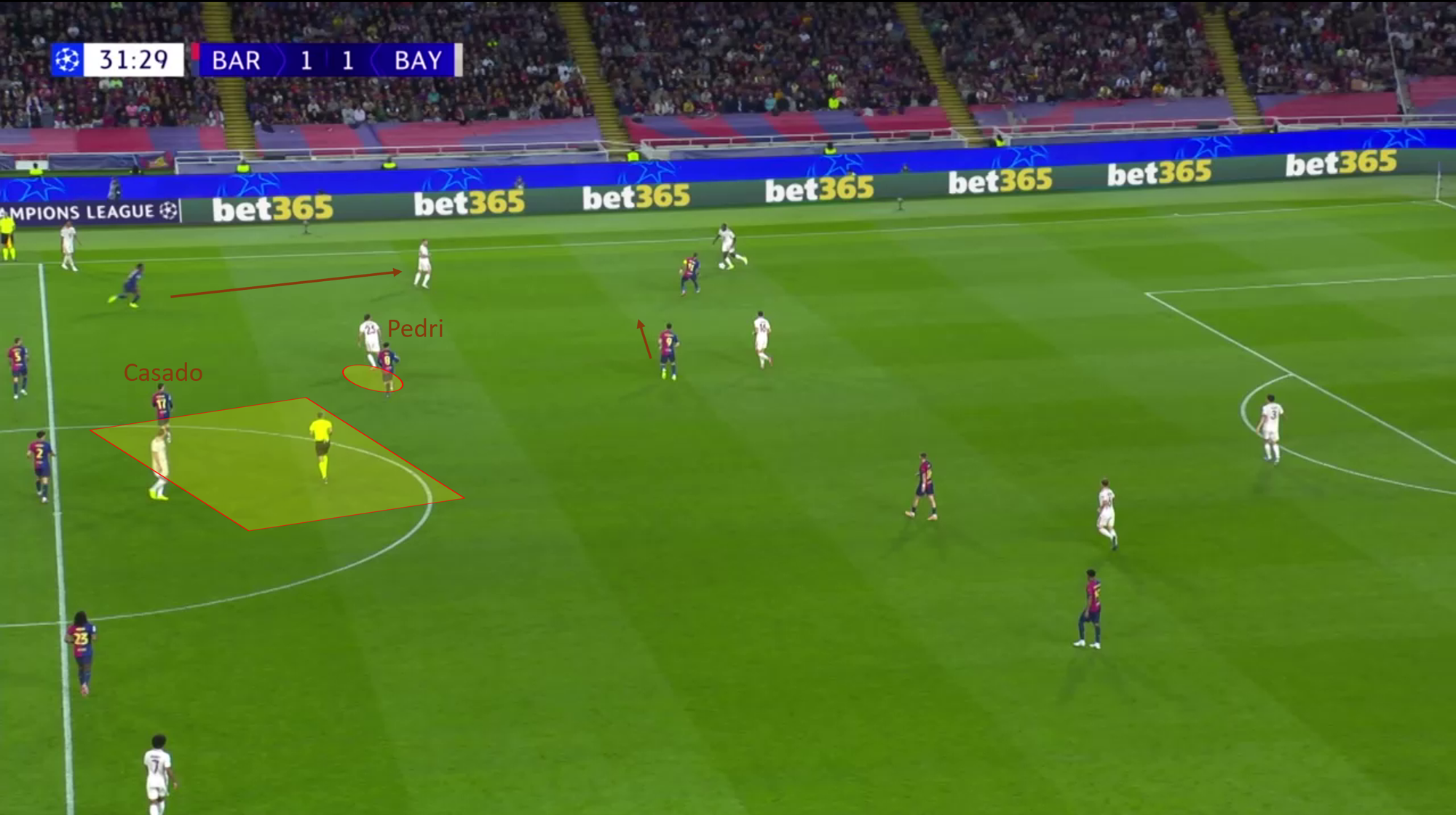
The absence of Jamal Musiala was particularly noticeable during this phase.
Like Pedri and Yamal, Musiala is frequently available deep in build-up play while under attacking pressure and can extricate himself from 1v1 or even 1v2/3 situations.
His presence alleviates pressure on his teammates, as Barcelona would not have been able to press as aggressively.
It is quite possible that the game could have had a completely different outcome with a fit Musiala.
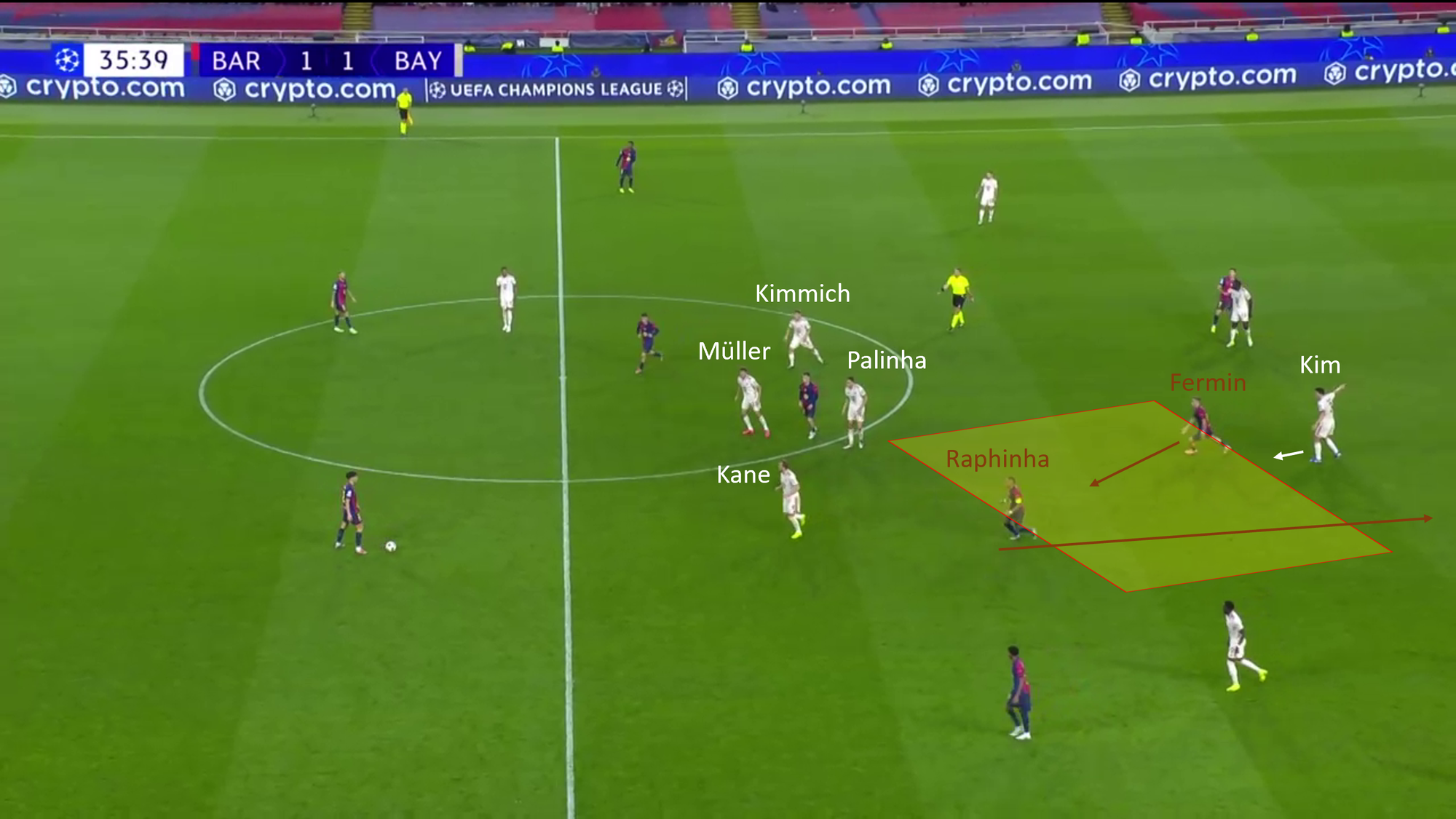
The 2-1 goal followed Barcelona’s possession phase.
However, this was preceded by several individual mistakes from Bayern’s players.
Kane pressed too hesitantly from Bayern’s mid-block to put pressure on the ball carrier, Palhinha failed to take over Raphinha, Kane’s opponent, and the passing lanes into the space between the lines were not closed off at all.
Additionally, Kim was caught off guard by an opposing movement, misjudged a long ball, and Manuel Neuer made an error when coming off his line as well; it was a completely avoidable goal.
Barcelona’s Counterattacking Football Against Bayern’s Rest Defense
Bayern were now forced to attack significantly higher, but Hansi Flick’s Barcelona made excellent use of Raphinha’s speed advantages.
He positioned himself as far away from the ball as possible against the slightly slower Guerreiro or Kimmich, aiming to be available for a deep diagonal ball once possession was regained.
Both the 3-1 and 4-1 goals resulted from Barcelona winning the ball and playing a diagonal pass to the deep-running Raphinha, who easily outpaced Bayern’s high defensive line in the footrace.
Conclusion
Barcelona vs Bayern Munich on matchday 3 was an incredibly entertaining match.
Numerous chances on both sides ultimately resulted in a clear winner.
This game served as a showcase for football due to the exceptionally high risk-taking displayed by both teams.
Personally, I would appreciate less criticism of teams that play boldly and more criticism of dreary, fearful football.
As a football enthusiast, I am a big fan of high defensive lines and defensive risk-taking, and I sincerely hope that more teams will take inspiration from this style of football.

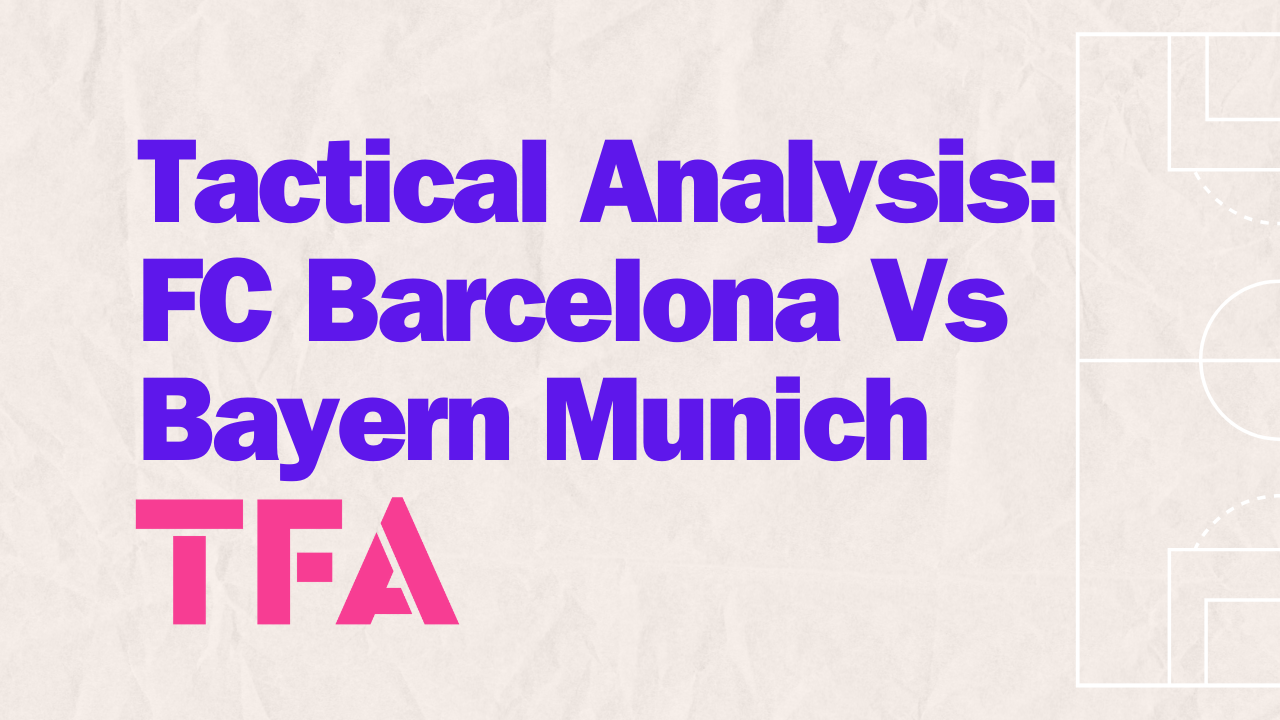




Comments